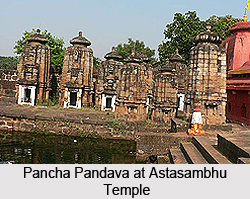 Astasambhu Shiva Temples is a collection of eight (8) Hindu temples dedicated to Lord Shiva located in Bhubaneshwar, the capital of Odisha. The 8 main Shiva lingams that are found in these 8 temples are "Kanakeswar", "Swapneswar", "Aisneswar", "Kapileswar", "Baidhyanatheswar", "Baneswar" and "Lokanatheswar". "Astasambhu Temple" is one of the 8 temples that are within the area of the Uttareswara Temple. In the Uttareswara Shiva Temple complex there are 8 temples of identical size and dimension locally known as "Astasambhu". "Asta" means eight and "Sambhu" refers to another name of Lord Shiva. Five of them are arranged in one alignment are also known as "Panch Pandava".
Astasambhu Shiva Temples is a collection of eight (8) Hindu temples dedicated to Lord Shiva located in Bhubaneshwar, the capital of Odisha. The 8 main Shiva lingams that are found in these 8 temples are "Kanakeswar", "Swapneswar", "Aisneswar", "Kapileswar", "Baidhyanatheswar", "Baneswar" and "Lokanatheswar". "Astasambhu Temple" is one of the 8 temples that are within the area of the Uttareswara Temple. In the Uttareswara Shiva Temple complex there are 8 temples of identical size and dimension locally known as "Astasambhu". "Asta" means eight and "Sambhu" refers to another name of Lord Shiva. Five of them are arranged in one alignment are also known as "Panch Pandava".
Astasambhu Shiva Temple specifically is surrounded by the Astasambhu Temple VI in the north, vast Godavari tank in the south, a huge compound wall in the east and the Pancha Pandava Temples in the west. This temple has a west facing shrine. The Ganesh temple in the vicinity is a huge attraction because of the rare position of the God. The temple is under the private ownership and is maintained by the Ratnakara Gargabatu and family.
Astasambhu Temple houses a cluster of 8 Shiva lingams made of precious stones. Each one of them is of a different colour. Some are white while some are red and black. Thus they are very appealing to devotees. The Shiva Lingas appear to be in different colours when looked at from different directions due to the reflection of the Sun, their colour changes.
 Legend of Astasambhu Temple
Legend of Astasambhu Temple
The legend says that Ashta Sambhu cured once the ancient king from a fatal disease. As per the legend, the Shivalingams here are ones that were captured when the kings defeated opposing kingdoms.
History of Astasambhu Temple
Astasambhu temple was constructed in the 10th century AD. Dhenekal, the town in which the temple is situated currently, had the capital of Kualo or Karmula in the earlier days. The Kualo kingdom was then ruled by the shulki kings, who were the descendants of the Bahmukar generation of kings. Lord Shiva was the main deity of the Bahmukar kings; hence these temples came to be addressed as the Astasambhu temples.
Architecture of Astasambhu Temple
Astasambhu Temple belongs to the Kalinga architectural style. The basic material used for building is grey sandstone and dry masonry was the technique used in this temple. The Astasambhu Temple contains a vimana and a porch facing the front side. The vimana is 4.15m tall. The highlight of this temple is that, here, the deities and the architectural style is simple and has no ornaments on it, making it look all the more serene and ancient.
Visiting Information
The road of Dhenekal is very well connected to all other parts of the state. The nearest airport to this temple is Bhubaneshwar Airport which has direct and connecting flights to and from all major cities in the country. Again, Bhubaneshwar railway station is the nearest railhead from where the temple is just 2km away from the station.











